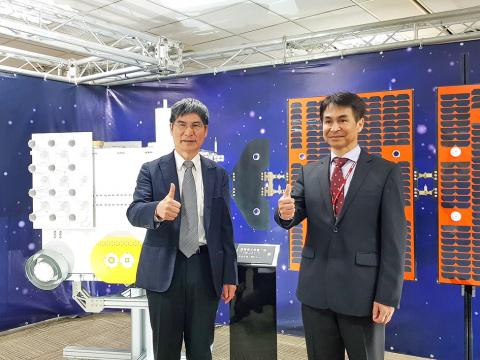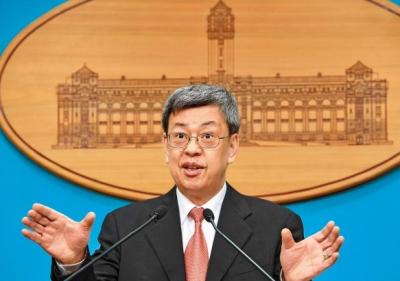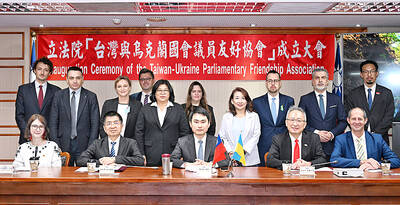The Ministry of Science and Technology yesterday announced plans to focus on the development of 10 small, high-resolution satellites for the third phase of the National Space Program.
The third phase, which is expected to cost NT$25.1 billion (US$814 million), was last month approved by Premier Su Tseng-chang (蘇貞昌).
It was the first official document he signed after taking office.

Photo: Chien Hui-ju, Taipei Times
It is to be executed by the National Applied Research Laboratories and the National Space Organization (NSPO) over a 10-year period starting this year, the ministry said.
The initiative would focus on the development of six prototype high-resolution optical remote sensing satellites, two ultra-high resolution smart optics remote sensing satellites and two synthetic aperture radar (SAR) satellites, it said.
It would also focus on the development of remote sensing technology and the use of smaller satellites to achieve higher resolution images, Minister of Science and Technology Chen Liang-gee (陳良基) said.
Citing an example, Chen said an ultra-high resolution smart optics remote sensing satellite weighing about 200kg would give users a 35cm view of the ground from an altitude of 510km, which would be the equivalent of spotting a cat or a dog in Pingtung County’s Kenting (墾丁) area from the Taipei 101 building.
The ministry plans to launch one satellite a year, he said, adding that the first is expected to be launched in 18 months.
The achievements of the first and second phases would serve as the foundation for the third phase, Chen said.
He hopes that the National Space Program would encourage innovation in the field of science, he added.
The prototype high-resolution optical remote sensing satellite constellation, which is to include three sets of two satellites, would raise the frequency of Formosat-5’s revisit rate from once every two days to twice or three times a day, NSPO director-general Lin Chun-liang (林俊良) said.
This would allow the ministry to gather more images, which has positive implications for the implementation of government policies, rescue missions, disaster prevention and scientific research, he said.
Ultra-high resolution smart optics remote sensing satellites focus on sub-meter resolution images, Lin said.
SAR satellites, which are equipped with active radar, are unaffected by cloud cover, fog or rainfall, which means they can function no matter the weather conditions or time of day, he said.
Other plans for the third phase include space exploration and the development of a satellite capable of orbiting the moon, Lin added.
As Taiwan lacks experience in these areas, it hopes to achieve its goal of space exploration by partnering with domestic and foreign academia, he said.
Having a satellite orbiting the moon would be the first step, he said.
Researchers would also explore ways to land a satellite on the moon, Lin added.
Without the assistance of GPS on the moon, the satellite would need to guide its own landing, he said.
Asked about the launch date of Formosat-7, Lin said that as Taiwan is partnering with the US for the launch, it would need to wait for the US to notify them.
Formosat-7’s six satellites are on standby at the NSPO, and can be packaged and delivered to the US as soon as it receives notice from the US, he said.
The ministry plans to launch Formosat-7 this year and a weather satellite called the “wind hunter” next year, Chen said.

Taiwan would welcome the return of Honduras as a diplomatic ally if its next president decides to make such a move, Minister of Foreign Affairs Lin Chia-lung (林佳龍) said yesterday. “Of course, we would welcome Honduras if they want to restore diplomatic ties with Taiwan after their elections,” Lin said at a meeting of the legislature’s Foreign Affairs and National Defense Committee, when asked to comment on statements made by two of the three Honduran presidential candidates during the presidential campaign in the Central American country. Taiwan is paying close attention to the region as a whole in the wake of a

President William Lai (賴清德) has appointed former vice president Chen Chien-jen (陳建仁) to attend the late Pope Francis’ funeral at the Vatican City on Saturday on his behalf, the Ministry of Foreign Affairs said today. The Holy See announced Francis’ funeral would take place on Saturday at 10am in St Peter’s Square. The ministry expressed condolences over Francis’ passing and said that Chen would represent Taiwan at the funeral and offer condolences in person. Taiwan and the Vatican have a long-standing and close diplomatic relationship, the ministry said. Both sides agreed to have Chen represent Taiwan at the funeral, given his Catholic identity and

Chinese Nationalist Party (KMT) Chairman Eric Chu (朱立倫), spokeswoman Yang Chih-yu (楊智伃) and Legislator Hsieh Lung-chieh (謝龍介) would be summoned by police for questioning for leading an illegal assembly on Thursday evening last week, Minister of the Interior Liu Shyh-fang (劉世芳) said today. The three KMT officials led an assembly outside the Taipei City Prosecutors’ Office, a restricted area where public assembly is not allowed, protesting the questioning of several KMT staff and searches of KMT headquarters and offices in a recall petition forgery case. Chu, Yang and Hsieh are all suspected of contravening the Assembly and Parade Act (集會遊行法) by holding

Lawmakers from the Democratic Progressive Party (DPP) yesterday established a friendship group with their counterparts in Ukraine to promote parliamentary exchanges between the two countries. A ceremony in Taipei for the Taiwan-Ukraine Parliamentary Friendship Association, initiated by DPP Legislator Chen Kuan-ting (陳冠廷), was attended by lawmakers and officials, including Deputy Minister of Foreign Affairs Francois Wu (吳志中) and European Economic and Trade Office in Taiwan Director Lutz Gullner. The increasingly dire situation in Ukraine is a global concern, and Taiwan cannot turn its back when the latter is in need of help, as the two countries share many common values and interests,